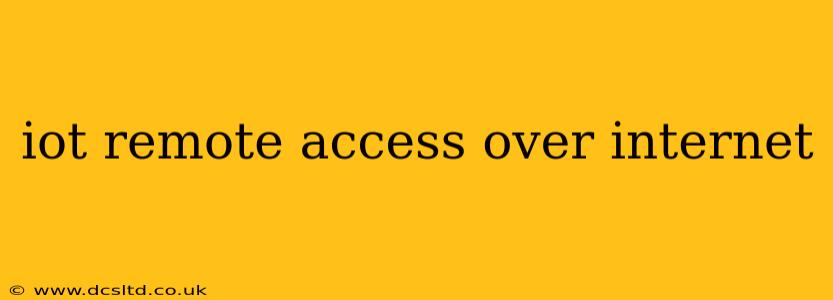The Internet of Things (IoT) has revolutionized how we interact with the world around us, connecting everyday devices and enabling remote control and monitoring. However, accessing these devices remotely over the internet presents significant security and usability challenges. This guide delves into the intricacies of secure and reliable IoT remote access, addressing common concerns and providing practical solutions.
What is IoT Remote Access?
IoT remote access refers to the ability to control and monitor IoT devices from anywhere with an internet connection. This can range from adjusting your smart thermostat while commuting home to remotely monitoring industrial equipment in a factory. The convenience is undeniable, but securing this access is crucial. Without proper security measures, your devices become vulnerable to hacking and malicious control.
How Does IoT Remote Access Work?
IoT remote access typically involves several key components:
- The IoT Device: This is the physical device you want to control remotely, such as a smart lock, security camera, or industrial sensor.
- Cloud Platform: A cloud-based service acts as an intermediary, providing secure communication channels and data storage. Popular platforms include AWS IoT Core, Azure IoT Hub, and Google Cloud IoT Core.
- Internet Connectivity: The IoT device and the user's device both need a stable internet connection to communicate.
- User Interface: A web or mobile application allows users to interact with their IoT devices remotely.
- Security Protocols: Robust security protocols are essential to protect against unauthorized access, data breaches, and malicious attacks.
What are the Security Risks of IoT Remote Access?
The open nature of the internet introduces several security risks when accessing IoT devices remotely:
- Data Breaches: Compromised devices can expose sensitive data to hackers.
- Unauthorized Access: Hackers can gain control of your devices, potentially causing damage or disruption.
- Denial-of-Service (DoS) Attacks: Overloading the device with requests can render it unusable.
- Malware Infections: Malicious software can infect devices and spread to other connected systems.
How to Secure IoT Remote Access?
Securing IoT remote access requires a multi-layered approach:
- Strong Passwords and Authentication: Use strong, unique passwords and consider multi-factor authentication (MFA) for added security.
- Secure Protocols: Implement secure communication protocols like HTTPS and TLS to encrypt data transmitted between devices and the cloud.
- Regular Software Updates: Keep your IoT devices and associated software updated with the latest security patches.
- Network Segmentation: Isolate your IoT network from your main home or office network to limit the impact of potential breaches.
- Firewall Protection: Configure firewalls to block unauthorized access attempts.
- Intrusion Detection Systems (IDS): Monitor network traffic for suspicious activity and alert you to potential threats.
- VPN Usage: Consider using a Virtual Private Network (VPN) to encrypt your internet traffic and enhance security.
What are the Different Methods of IoT Remote Access?
Several methods enable IoT remote access, each with its pros and cons:
- Cloud-Based Platforms: These offer scalable, managed solutions with built-in security features. However, they may require a subscription fee.
- Direct Internet Access (DIY): This approach requires more technical expertise but offers greater control. However, it increases the risk of security vulnerabilities if not properly configured.
- Reverse Proxies: These act as intermediaries between the internet and your IoT devices, enhancing security and simplifying access management.
What Protocols are Used for IoT Remote Access?
Several protocols facilitate secure remote access:
- MQTT (Message Queuing Telemetry Transport): A lightweight messaging protocol ideal for constrained IoT devices.
- CoAP (Constrained Application Protocol): Another lightweight protocol designed for resource-constrained environments.
- HTTP/HTTPS: Widely used protocols providing secure communication over the internet.
How Can I Improve the Security of My IoT Devices?
Implementing best practices significantly improves the security of your IoT devices:
- Change Default Passwords: Never use default passwords provided by manufacturers.
- Enable Two-Factor Authentication (2FA): Add an extra layer of security with 2FA whenever possible.
- Keep Firmware Updated: Regularly check for and install firmware updates to patch security vulnerabilities.
- Monitor Network Activity: Use network monitoring tools to detect unusual activity.
Choosing the Right IoT Remote Access Solution
Selecting the best solution depends on your specific needs and technical expertise. Consider factors like scalability, security features, ease of use, and cost when making your decision. Prioritizing security should always be paramount.
By understanding the challenges and implementing robust security measures, you can harness the power of IoT remote access while mitigating the associated risks, ensuring a secure and reliable connection to your devices.
